· Cuban Jade
![]()
· Cuban Jade
![]()
Citation of this webpage: García-Casco, A., Cárdenas Párraga, J., Rodríguez Vega, A., Núñez Cambra, K., Harlow, G. (2009) Cuban Jade. http://www.ugr.es/~agcasco/igcp546/ >> Carib Met Geol >> Jade

Chinese words for jade (thanks to Tatsuki Tsujimori for correct spelling!)
The following text is taken from: García-Casco, A., Rodríguez Vega, A., Cárdenas Párraga, J., Iturralde-Vinent, M. A., Lázaro, C., Blanco Quintero, I., Rojas- Agramonte, Y., Kröner, A., Núñez Cambra, K., Millán, G., Torres-Roldán, R. L., Carrasquilla, S. (2009) A new jadeitite jade locality (Sierra del Convento, Cuba): First report and some petrological and archaeological implications. Contributions to Mineralogy and Petrology ("online first"). DOI: 10.1007/s00410-008-0367-0. See this paper for references cited.
Jade is a gemological term embracing actinolite-tremolite amphibolitite rocks (termed nephrite jade) and jadeite pyroxenite rocks or jadeitite (jadeite jade). Nephrite jade is a metasomatic rock that forms in a variety of petrologic-geologic settings, including the replacement of dolomitic marble by Si-rich fluids associated with magmatic rocks in contact aureoles and the replacement of meta-ultramafic rocks (serpentinite) by Ca-rich fluids in (tectonic) interfaces between serpentinite and Si-rich rocks such as plagiogranite, greywacke, argillite or chert (Harlow and Sorensen 2005). Jadeite jade, in turn, is found almost exclusively associated with serpentinite, generally within serpentinite-matrix tectonic mélanges containing exotic blocks formed in high-pressure subduction environments (Harlow and Sorensen 2005). The temperature of crystallization of jadeite jade is generally relatively low (250-550 ºC), as documented by in-situ jadeitite deposits where antigoritite forms the wall rock of jade bodies. Harlow and Sorensen (2005) noted the scarcity of jadeitite in high-pressure complexes, citing only 12 localities in Myanmar, Guatemala, Russia, Kazakhstan, Japan, California, Italian Alps, and Turkey. Sorensen et al. (2006) cited only eight “well documented, primary, hard-rock occurrences” of jadeitite jade. Recently, new jadeitite localities have been documented in Iran (Oberhänsli et al. 2007) and Dominican Republic (Schertl et al. 2007a, 2007b, Baese et al. 2007) [and Cuba, García-Casco et al., 2009]. Harlow and Sorensen (2005) indicated that, in spite of probable fairly common formation of jadeitite in subduction environments, complex sequences of tectonic of events/conditions should concur in order to exhume serpentinite-matrix mélanges bearing jadeitite.
Metasomatism of blocks of trondhjemite, plagiogranite, (meta)granitoid, leucogabbro, eclogite, metapelite, and metagreywacke has been classically considered the main jadeitite-forming process (see review by Harlow and Sorensen 2005 for complete list of references). However, these authors have noted a number of problems with this interpretation, including the common lack of protoliths and protolith replacement textures, severe mass-balance problems, and the common occurrence of idiomorphic oscillatory zoning of jadeite. After reviewing worldwide jadeitite occurrences, Harlow and Sorensen (2005; see also Sorensen et al. 2006) emphasized that jadeite precipitates directly from fluids evolved at depth. This conclusion makes this type of rock of interest for the direct characterization of fluids and fluid-assisted processes in the subduction environment, including processes of mass transfer from the downgoing slab to the upper plate which may ultimately lead to the formation of arc magmas.
Jadeitite and jadeite-bearing rocks are scarce in the Caribbean region. Rare river pebbles of jadeitite of unknown in-situ location were found in the Cretaceous subduction complex of Escambray, central Cuba, by Millán and Somin (1981). This “old” finding has reached only limited audience due to editorial and language problems. However, only a brief petrographic description was made available by Millán and Somin (1981), who indicate radial aggregates of jadeite and isolated grains of clinozoisite, lawsonite and albite. Rare relictic presumably magmatic clinopyroxene partly replaced by fine-grained jadeite led these authors to suggest formation of jadeitite by replacement of basic intrusive bodies, implying metasomatic origin. A variety of jadeitite and jadeite-bearing rocks have been recently discovered in the Cretaceous subduction mélange of Río San Juan, Dominican Republic (Schertl et al. 2007a, 2007b; Baese et al. 2007, Krebs et al. 2008). The available information suggests complex processes including direct precipitation from fluid. The high-pressure Escambray complex and Rio San Juan mélange may be geologically correlated to Cretaceous high pressure complexes of central Guatemala (Motagua Valley region), where jadeitite is abundant and varied in terms of P-T conditions of formation (Harlow 1994; Harlow et al. 2003).
[Recently, García-Casco et al., 2009] document for the first time the occurrence of jadeite jade in eastern Cuba. The new locality is in the subduction mélange of Sierra del Convento, which correlates with the Rio San Juan mélange (García-Casco et al. 2008a; Lázaro et al. 2009). These mélanges and the Escambray complex may have formed in the same subduction zone, but the latter mostly records late Cretaceous subduction-accretion of margin-like sediments (García-Casco et al. 2008b) while the former record mid-late subduction of oceanic material. ... The Sierra del Convento mélange shows abundant evidence for fluid circulation in the subduction environment. In particular, fluid infiltration triggered metasomatism and partial melting of subducted ocean crust (García-Casco et al. 2008a; Lázaro and García-Casco 2008), a process hardly ever seen in other worldwide occurrences of oceanic subduction complexes exhumed to the Earth’s surface (e.g., Sorensen and Barton 1987; Sorensen 1988). Partial melts crystallized in the subduction environment (García-Casco 2007; García-Casco et al. 2008a) and evolved fluids that formed pegmatitic and hydrothermal rocks that may have had to do with jadeite formation. Also, the mélange contains a high quantity of pure rock crystal quartz in hydrothermal veins and blocks prospected for electronic applications (Kulachlov and Leyva 1990; Leyva 1996).
[These] findings of jadeitite in the Caribbean region open new archaeological perspectives for the source of pre-Columbian jade artifacts found in the Antilles.
Plate tectonic scheme of the Caribbean region, with important geological features including ophiolitic bodies and location of geological jadeitite source regions and of archeological locations of Caribbean jade artifacts (Slightly modified after García-Casco, A., Rodríguez Vega, A., Cárdenas Párraga, J., Iturralde-Vinent, M. A., Lázaro, C., Blanco Quintero, I., Rojas- Agramonte, Y., Kröner, A., Núñez Cambra, K., Millán, G., Torres-Roldán, R. L., Carrasquilla, S. (2009) A new jadeitite jade locality (Sierra del Convento, Cuba): First report and some petrological and archaeological implications. Contributions to Mineralogy and Petrology ("online first"). DOI: 10.1007/s00410-008-0367-0). To be updated.
Subduction-related hydrothermal origin of jadeitite jade
Fluids evolved from an oceanic slab (figure 1 from J.-I. Kimura, B. R. Hacker, P. E. van Keken, H. Kawabata, T. Yoshida, and R. J. Stern. Arc Basalt Simulator version 2, a simulation for slab dehydration and fluid-fluxed mantle melting for arc basalts: Modeling scheme and application. Geochem. Geophys. Geosyst., 10, 9, Q09004, doi:10.1029/2008GC002217, 2009).
The subduction channel.
Amount of fluids evolved from slabs. (Figure from: B. R. Hacker. H2O subduction beyond arcs. Geochem. Geophys. Geosyst., 9, 3, doi:10.1029/2007GC001707, 2008)
Hydrothermal mode of formation of a vein of jade (figure taken from: Harlow GE and Sorensen SS (2005) Jade (nephrite and jadeitite) and serpentinite: metasomatic connections. Int Geol Review 47:113-146).
High-pressure metamorphic complexes in the Caribbean (ca. 140 - 25 Ma).
Cuban (Sierra del Convento) Geological Jade
Location of Sierra del Convento jade (from García-Casco, A., Rodríguez Vega, A., Cárdenas Párraga, J., Iturralde-Vinent, M. A., Lázaro, C., Blanco Quintero, I., Rojas- Agramonte, Y., Kröner, A., Núñez Cambra, K., Millán, G., Torres-Roldán, R. L., Carrasquilla, S. (2009) A new jadeitite jade locality (Sierra del Convento, Cuba): First report and some petrological and archaeological implications. Contributions to Mineralogy and Petrology ("online first"). DOI: 10.1007/s00410-008-0367-0).
The Sierra del Convento (Guantanamo province, Cuba).
Outcrop aspect of jade from the Sierra del Convento mélange.
Boulders in Neogene detrital marine formations.
Pebbles and boulders in Recent fluvial placer deposits
Pebbles and boulders in Recent beach placer deposits
Hand specimens
Raw jade material from Sierra del Convento. The blackish band and nodules are rich in omphacite, while the light green material is almost pure jadeitite (from García-Casco, A., Rodríguez Vega, A., Cárdenas Párraga, J., Iturralde-Vinent, M. A., Lázaro, C., Blanco Quintero, I., Rojas- Agramonte, Y., Kröner, A., Núñez Cambra, K., Millán, G., Torres-Roldán, R. L., Carrasquilla, S. (2009) A new jadeitite jade locality (Sierra del Convento, Cuba): First report and some petrological and archaeological implications. Contributions to Mineralogy and Petrology ("online first"). DOI: 10.1007/s00410-008-0367-0).
Varieties of jadeitite jade from the Sierra del Convento mélange, eastern Cuba (photographs by Juan Cárdenas Párraga).
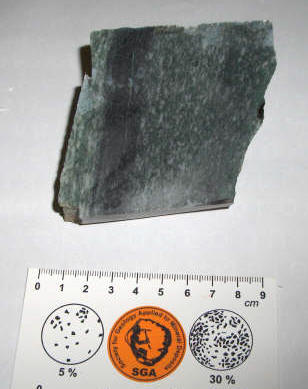
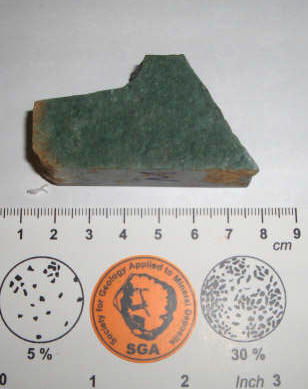
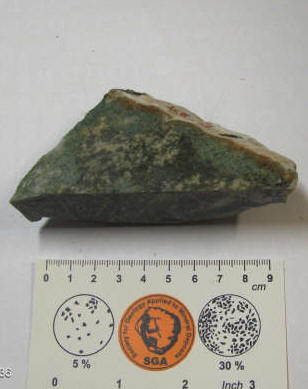
Varieties of nephite jade from eastern Cuba (photograph by Juan Cárdenas Párraga).
Polished jade from the Sierra del Convento (photograph by Antonio Rodríguez Vega).
Cuban Archaeological Jade
Distribution of Taino culture (ca. 800 - 1500 A.D.).
Taino culture in Cuba (ca. 1000 - 1500 A.D.). San Antonio del Sur Museum.
Taino culture (ca. 1000 - 1500 A.D.). Lithic artifacts and ceramics. San Antonio del Sur Museum.
Collection of Taino jade and non-jade artifacts from the Montané Museum, Havana (photograph by George Harlow, 2009).
Non-jade Taino idols, Gabinete de Arqueología, Oficina del Historiador de la Ciudad de La Habana (photograph by Gabinete de Arqueología OHCH). Doesn't the one located to the right look "exotic"?
Left) Non-jade Taino idol (zemi), Gabinete de Arqueología, Oficina del Historiador de la Ciudad, de la Habana, OHCH. Right) Non-jade Taino idol, Montané Museum, La Habana.
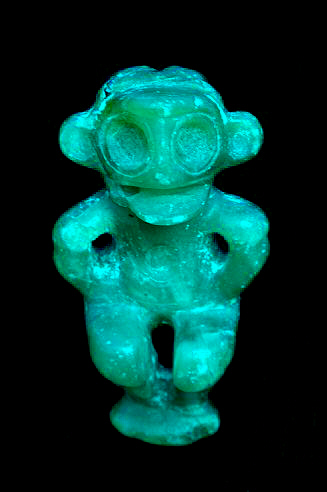
George Harlow inspecting a jade artifact from the Montané Museum, Havana (photograph by Antonio García-Casco, 2009).
Jade and non-jade axes from San Antonio del Sur Museum, Guantánamo province, Cuba (photograph by Antonio Rodríguez Vega)
Taino jadeitite jade axe. The material is a tectonic? breccia made of broken fragments of (probable) jadeitite (green) in a matrix of late (probable) omphacitite (black). (photographs by Antonio Rodríguez Vega).
Fragment of Taino jadeitite jade axe, Baracoa region, eastern Cuba (photographs by Juan Cárdenas Párraga).
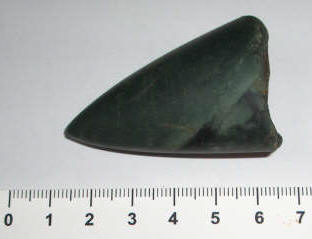
Jade (left) and non-jade (right) Taino axes from San Antonio del Sur Museum, Guantánamo province, Cuba (photograph by Antonio Rodríguez Vega).
Ariadna Mendoza, with her XRD and XRF self-designed apparatus for archaeometic analysis. She is now working on Cuban archaeological artifacts. Gabinente de Arqueometría, Oficina del Historiador de la Ciudad, de la Habana, OHCH.
The Cuban Jade Gang
George Harlow, Antonio García-Casco, Kenya Núñez Cambra, Juan Cárdenas Párraga, Antonio (Ñico) Rodríguez Vega.
last modified: 03.19.10 08:52 +0100